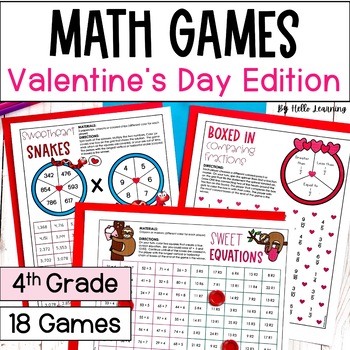Valentine's Day Math Games for 4th Grade - Fractions, Multiplication, Division
- PDF
Description
These Valentine's Day math games are the perfect activities to keep your students engaged in learning during the month of February! These printable math games cover 4th grade math standards and are great for practice and review! Low prep for teachers, fun for students!
Click the PREVIEW button to see more details of what is included!
⭐ This resource includes:
- 18 printable math games (each game is provided in color and black & white)
- Answer keys
- Directions and suggestions for use
⭐ The 18 Valentine's Day math games and skills in this resource include:
- Four in a Row Candy Hearts – 2 digit by 1 digit multiplication
- Capture the Candies - Adding fractions - 10ths and 100ths
- Boxed In - Comparing fractions to 1/2
- Roll, Solve, Race! - Long division - 3 digit ÷ 1 digit
- Roll & Cover - Divisibility
- Multiplicative Comparison BUMP - Multiplicative comparison
- Sweetheart Snakes - 3 digit by 1 digit multiplication
- Equivalent Fraction BUMP - Equivalent fractions with models
- Comparing Fractions - Comparing fractions with <, > or =
- Fractions and Decimals - Converting fractions to decimals - 10ths and 100ths
- Subtracting Fractions - Subtracting like mixed numbers
- Add Like Fractions BUMP - Adding like fractions - no simplifying or renaming
- Add Like Fractions BUMP - Adding like fractions - simplify or rename answers
- Capture the Valentine Cards - Expanded form with whole numbers
- Sweet Equations - Long division - 2 digit ÷ 1 digit with remainders
- Covering Cupcakes - Multiplying unit fractions by whole numbers
- Subtracting Fractions BUMP - Subtracting like fractions
- Mixed Number Addition - Adding mixed numbers with like denominators
⭐ There are many ways to use these games:
- Math centers or stations
- Small groups
- Morning work
- Partner activities
- Early finishers
- Homework – family math activity
- Sub plans
- Enrichment
- Skill review
- Math choice time
- Tutoring
- Test prep
More Valentine's Day Resources You May Like:
Valentine's Day Logic and Brain Teasers
Follow me and be notified when new products are added to my store.
New products are always 50% off for the first 24 hours they are posted!
Thanks!
Dawn - Hello Learning
***Did you know that leaving feedback on your TpT purchases earns you credits that will save you money? Go to your ‘My Purchases’ page and leave feedback on the resources you’ve purchased to earn TPT credits toward future purchases!





